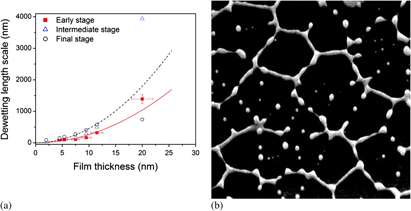Crossref Citations
This article has been cited by the following publications. This list is generated based on data provided by
Crossref.
Gu, Deen
Zhang, Cheng
Wu, Yi-Kuei
and
Guo, L. Jay
2014.
Ultrasmooth and Thermally Stable Silver-Based Thin Films with Subnanometer Roughness by Aluminum Doping.
ACS Nano,
Vol. 8,
Issue. 10,
p.
10343.
Fowlkes, J. D.
Roberts, N. A.
Wu, Y.
Diez, J. A.
González, A. G.
Hartnett, C.
Mahady, K.
Afkhami, S.
Kondic, L.
and
Rack, P. D.
2014.
Hierarchical Nanoparticle Ensembles Synthesized by Liquid Phase Directed Self-Assembly.
Nano Letters,
Vol. 14,
Issue. 2,
p.
774.
El-Sayed, Hany A.
Horwood, Corie A.
Owusu-Ansah, Ebenezer
Shi, Yujun J.
and
Birss, Viola I.
2015.
Gold nanoparticle array formation on dimpled Ta templates using pulsed laser-induced thin film dewetting.
Physical Chemistry Chemical Physics,
Vol. 17,
Issue. 16,
p.
11062.
Chiu, Wei-Jane
Ling, Tsung-Kai
Chiang, Hai-Pang
Lin, Han-Jia
and
Huang, Chih-Ching
2015.
Monitoring Cluster Ions Derived from Aptamer-Modified Gold Nanofilms under Laser Desorption/Ionization for the Detection of Circulating Tumor Cells.
ACS Applied Materials & Interfaces,
Vol. 7,
Issue. 16,
p.
8622.
Dimitriou, Vasilis
Kaselouris, Evaggelos
Orphanos, Yannis
Bakarezos, Makis
Vainos, Nikolaos
Nikolos, Ioannis K.
Tatarakis, Michael
and
Papadogiannis, Nektarios A.
2015.
The thermo-mechanical behavior of thin metal films under nanosecond laser pulse excitation above the thermoelastic regime.
Applied Physics A,
Vol. 118,
Issue. 2,
p.
739.
Owusu-Ansah, Ebenezer
Horwood, Corie A.
El-Sayed, Hany A.
Birss, Viola I.
and
Shi, Yujun J.
2015.
A method for the formation of Pt metal nanoparticle arrays using nanosecond pulsed laser dewetting.
Applied Physics Letters,
Vol. 106,
Issue. 20,
Qi, Dongfeng
Paeng, Dongwoo
Yeo, Junyeob
Kim, Eunpa
Wang, Letian
Chen, Songyan
and
Grigoropoulos, Costas P.
2016.
Time-resolved analysis of thickness-dependent dewetting and ablation of silver films upon nanosecond laser irradiation.
Applied Physics Letters,
Vol. 108,
Issue. 21,
Cangueiro, Liliana T
Cavaleiro, André J
Morgiel, Jerzy
and
Vilar, Rui
2016.
Mechanisms of the formation of low spatial frequency LIPSS on Ni/ Ti reactive multilayers.
Journal of Physics D: Applied Physics,
Vol. 49,
Issue. 36,
p.
365103.
Diez, Javier A.
and
González, Alejandro G.
2016.
Breakup of Thin Liquid Filaments on Partially Wetting Substrates: from Micrometric to Nanometric Scales.
Brazilian Journal of Physics,
Vol. 46,
Issue. 2,
p.
225.
Grochowska, Katarzyna
Siuzdak, Katarzyna
Macewicz, Łukasz
Skiba, Franciszek
Szkoda, Mariusz
Karczewski, Jakub
Burczyk, Łukasz
and
Śliwiński, Gerard
2017.
Nanostructuring of thin Au films deposited on ordered Ti templates for applications in SERS.
Applied Surface Science,
Vol. 418,
Issue. ,
p.
472.
Grochowska, Katarzyna
Siuzdak, Katarzyna
Karczewski, Jakub
Szkoda, Mariusz
and
Śliwiński, Gerard
2017.
Properties of Thermally Dewetted Thin Au Films on ITO-Coated Glass for Biosensing Applications.
Plasmonics,
Vol. 12,
Issue. 6,
p.
1939.
Kalfagiannis, Nikolaos
Koutsogeorgis, Demosthenes C.
Lidorikis, Elefterios
and
Patsalas, Panos
2017.
Nanoplasmonics - Fundamentals and Applications.
Bellas, D.V.
Toliopoulos, D.
Kalfagiannis, N.
Siozios, A.
Nikolaou, P.
Kelires, P.C.
Koutsogeorgis, D.C.
Patsalas, P.
and
Lidorikis, E.
2017.
Simulating the opto-thermal processes involved in laser induced self-assembly of surface and sub-surface plasmonic nano-structuring.
Thin Solid Films,
Vol. 630,
Issue. ,
p.
7.
Luan, Yanhua
Li, Yanru
Nie, Tiaoping
Yu, Jun
and
Meng, Lijun
2018.
Molecular dynamics study of the growth of a metal nanoparticle array by solid dewetting.
Journal of Nanoparticle Research,
Vol. 20,
Issue. 3,
Qi, Dongfeng
Huang, Shihao
Wang, Letian
Shi, Meng
Chen, Songyan
and
Grigoropoulos, Costas P.
2018.
Nanosecond laser induce size-controllable SiGe islands with high Ge composition, large aspect ratio and defect-free characteristics.
Materials Letters,
Vol. 211,
Issue. ,
p.
250.
Demille, Trevor B.
Hughes, Robert A.
and
Neretina, Svetlana
2019.
Periodic Arrays of Dewetted Silver Nanostructures on Sapphire and Quartz: Effect of Substrate Truncation on the Localized Surface Plasmon Resonance and Near-Field Enhancement.
The Journal of Physical Chemistry C,
Vol. 123,
Issue. 32,
p.
19879.
Fulton, Alison Joy
Ozhukil Kollath, Vinayaraj
Karan, Kunal
and
Shi, Yujun
2020.
Gold nanoparticle assembly on porous silicon by pulsed laser induced dewetting.
Nanoscale Advances,
Vol. 2,
Issue. 2,
p.
896.
Owusu-Ansah, Ebenezer
Birss, Viola I.
and
Shi, Yujun
2020.
Mechanisms of Pulsed Laser-Induced Dewetting of Thin Platinum Films on Tantalum Substrates—A Quantitative Study.
The Journal of Physical Chemistry C,
Vol. 124,
Issue. 42,
p.
23387.
Zhang, Cheng
Ji, Chengang
Park, Yong‐Bum
and
Guo, L. Jay
2021.
Thin‐Metal‐Film‐Based Transparent Conductors: Material Preparation, Optical Design, and Device Applications.
Advanced Optical Materials,
Vol. 9,
Issue. 3,
Ly, Linh Quy
Fulton, Alison Joy
Bonvicini, Stephanie Nicole
and
Shi, Yujun
2021.
Pulsed laser-induced dewetting and thermal dewetting of Ag thin films for the fabrication of Ag nanoparticles.
Nanotechnology,
Vol. 32,
Issue. 33,
p.
335301.



